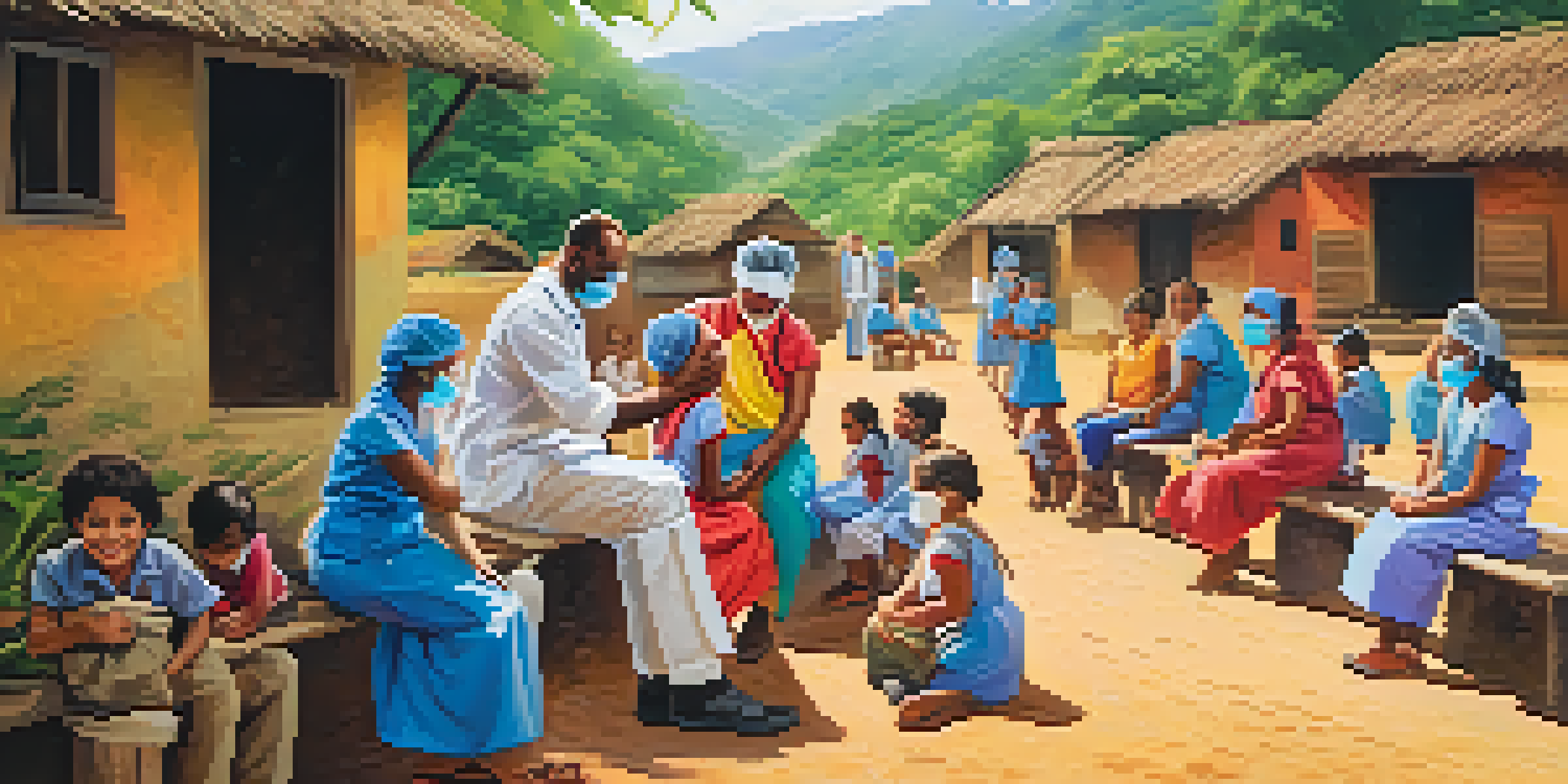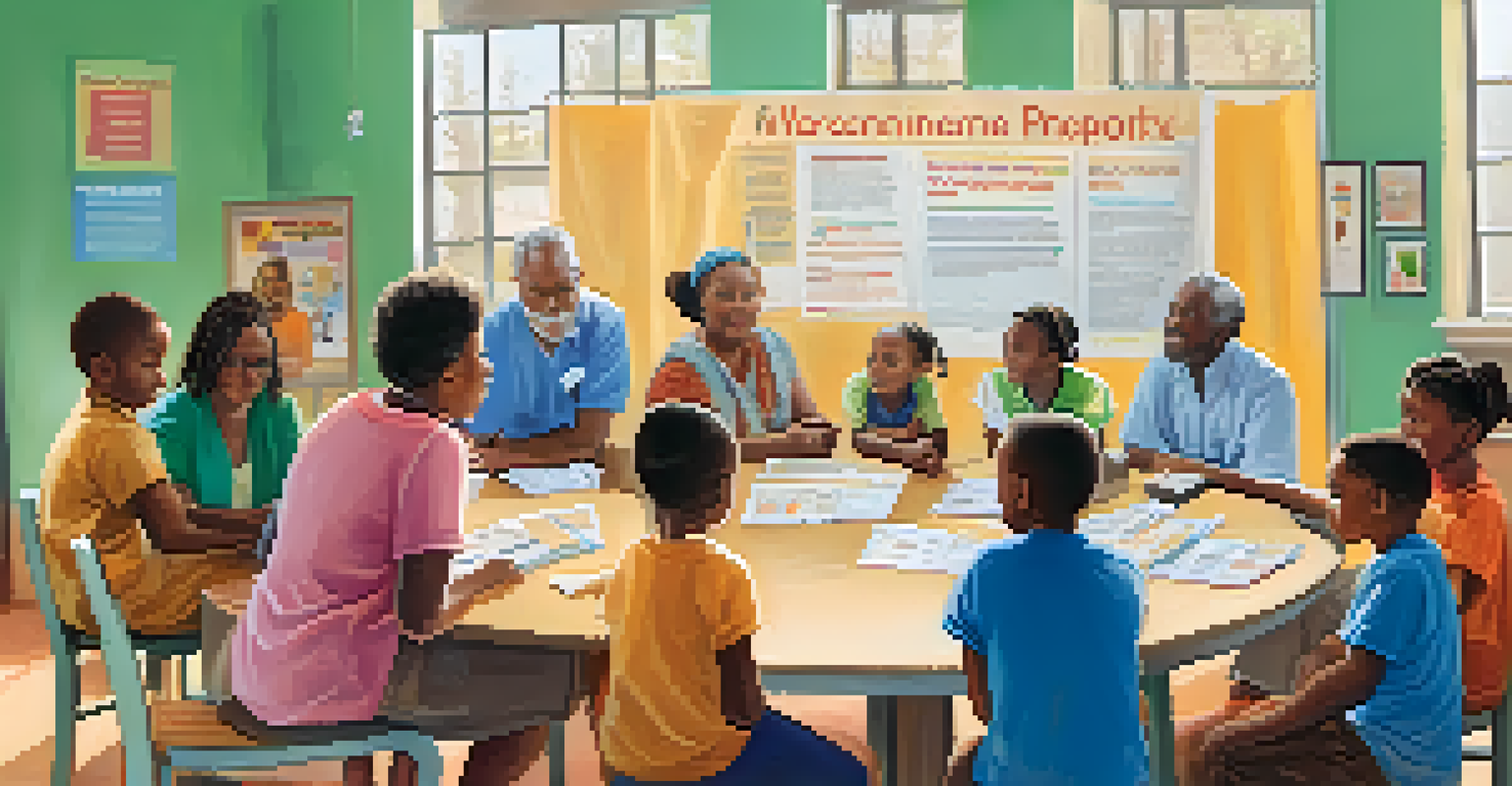Global Vaccination Efforts: Success Stories and Challenges

The Power of Global Vaccination Initiatives
Global vaccination initiatives have played a pivotal role in reducing the spread of infectious diseases. Programs like GAVI, the Vaccine Alliance, have successfully increased access to vaccines in low-income countries, showcasing how collaboration can lead to tangible results. For instance, the introduction of the pneumococcal vaccine in several African nations significantly lowered child mortality rates.
Vaccines are the tugboats of preventive health.
These efforts demonstrate that when resources are pooled together, communities benefit immensely. The partnership between governments, NGOs, and private sectors has led to innovative funding models that ensure vaccines reach those in need. This shows us that collective action can pave the way for healthier populations, transforming lives in the process.
However, it’s essential to recognize that while we celebrate these successes, the journey is ongoing. The continuous push for equitable vaccine distribution highlights the importance of sustained commitment and collaboration to overcome remaining barriers.
Success Story: The Eradication of Smallpox
One of the most remarkable success stories in vaccination history is the eradication of smallpox. This deadly disease claimed millions of lives before the World Health Organization (WHO) launched a global vaccination campaign in the 1960s. By mobilizing resources and coordinating efforts across countries, smallpox was declared eradicated in 1980, marking a monumental public health achievement.

The lessons learned from this campaign are invaluable. It illustrated the effectiveness of targeted vaccination strategies and the importance of community engagement. For instance, health workers went door-to-door in remote areas, ensuring that no one was left unvaccinated, which played a crucial role in the campaign's success.
Global Vaccination Saves Lives
Collaborative initiatives like GAVI have significantly increased vaccine access in low-income countries, reducing mortality rates and showcasing the power of collective action.
Yet, as we celebrate this victory, we must remember that smallpox is a unique case. The global commitment to eradicate it was unparalleled, and replicating such efforts for other diseases presents new challenges that require innovative solutions.
Innovative Vaccine Development: A Game Changer
The rapid development of COVID-19 vaccines has revolutionized how we approach vaccine creation. Traditional timelines for vaccine development can span years, but the urgency of the pandemic led to unprecedented collaboration between scientists and pharmaceutical companies. Platforms like mRNA technology have emerged as game-changers, allowing for quicker and more effective responses to emerging infectious diseases.
The only way to win is to learn faster than anyone else.
This innovation highlights the potential of technology in addressing global health crises. With countries sharing data and resources, the global scientific community came together to tackle a common enemy. This spirit of collaboration not only accelerated vaccine availability but also built a framework for future developments.
However, as we celebrate these advancements, we must also consider the implications. The challenge now lies in ensuring that these vaccines are distributed equitably and that all populations have access to the latest medical advancements.
Hurdles in Vaccine Distribution and Access
Despite the successes in vaccination efforts, significant hurdles remain in distribution and access. Many countries, particularly in low-income regions, face logistical challenges such as inadequate infrastructure, limited healthcare resources, and political instability. These factors can hinder vaccination campaigns, leaving vulnerable populations at risk.
A vivid example is seen in rural areas where transportation barriers make it difficult for healthcare workers to reach communities. In some cases, vaccines may expire before they can be administered, compounding the issue of wasted resources. This reality emphasizes the need for innovative distribution strategies that consider local challenges.
Education Fights Vaccine Hesitancy
Public awareness campaigns that involve local leaders can effectively combat misinformation and build trust in vaccines, encouraging higher vaccination rates.
Furthermore, there’s a pressing need for global solidarity. Wealthier nations must support low-income countries through funding and resource sharing to ensure equitable access and bolster vaccine confidence among populations that remain hesitant.
The Role of Public Awareness and Education
Public awareness and education are critical components of successful vaccination efforts. Misinformation can create fear and hesitancy, leading to lower vaccination rates. Engaging communities through transparent communication and education campaigns can help address these concerns, fostering trust in vaccines.
For instance, grassroots initiatives that involve local leaders and health workers can effectively convey the importance of vaccines. By sharing stories from community members who have benefited from vaccinations, these campaigns create relatable narratives that resonate with audiences. This approach not only informs but also builds a community around the importance of public health.
However, the fight against misinformation is ongoing. As digital platforms continue to spread both knowledge and myths, it's crucial for health organizations to adapt their strategies and ensure accurate information reaches all corners of society.
Addressing Vaccine Hesitancy: A Global Challenge
Vaccine hesitancy is a growing concern worldwide, posing a significant barrier to achieving herd immunity. Factors contributing to hesitancy can range from misinformation to cultural beliefs, making it a complex issue to tackle. Understanding the root causes of hesitancy is essential for developing effective strategies to encourage vaccination.
For example, some communities may have historical mistrust of healthcare systems due to past injustices. Engaging with these communities through respectful dialogue and acknowledging their concerns can help bridge the gap. Building relationships with trusted local figures can also enhance credibility and encourage more individuals to get vaccinated.
Future Needs Focus on Equity
To address emerging health challenges, global vaccination efforts must prioritize equity, innovation, and robust healthcare infrastructure to ensure all populations have access to life-saving vaccines.
Addressing vaccine hesitancy requires a multifaceted approach that combines education, transparency, and empathy. It’s not just about providing information but also about fostering a supportive environment where individuals feel heard and valued.
Future Directions for Global Vaccination Efforts
Looking ahead, global vaccination efforts must adapt to meet new challenges and opportunities. As we face emerging infectious diseases and variants, the importance of maintaining robust vaccination programs cannot be overstated. Investing in research and development is crucial to ensure that vaccines remain effective and accessible.
Moreover, strengthening healthcare systems globally will create a more resilient infrastructure for future vaccination campaigns. This includes enhancing supply chains, improving health worker training, and ensuring that communities are equipped to respond to health crises effectively. The lessons learned from the COVID-19 pandemic can guide these improvements.

Ultimately, the future of global vaccination efforts relies on collaboration, innovation, and a commitment to equity. By working together, we can create a healthier world where everyone has access to life-saving vaccines.